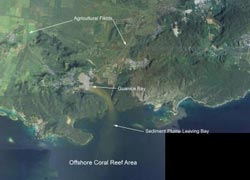High pollutant levels in Guánica Bay 'represent serious toxic threat' to corals

This is an aerial view of study area, Guánica Bay, Puerto Rico.<br><br>Credit: NOAA<br>
The pollutants measured in the sediments of Guánica Bay, Puerto Rico, in a new NOAA study were among the highest concentrations of PCBs, chlordane, chromium and nickel ever measured in the history of NOAA's National Status & Trends, a nationwide contaminant monitoring program that began in 1986.
Researchers from the National Ocean Service's National Centers for Coastal Ocean Science (NCCOS) studied the reef's ecology to help establish baseline conditions that coastal managers can use to measure changes resulting from new efforts to manage pollution. Among the items studied were habitat types, coral cover, fish and pollution stressors such as nutrients, sedimentation, toxic contaminants in Guánica Bay.
“These concentrations of pollutants represent serious toxic threats to corals, fish and benthic fauna — bottom dwelling animal life and plants,” said David Whitall, Ph.D., the report's principal investigator and NOAA ecologist. “We also observed lower indicators of biological health, such as how much of the coral covers the sea floor offshore from Guánica Bay when compared to an adjacent study area, La Parguera. Further research is needed to determine if this is the result of the toxins or some other cause. At this point, we cannot definitively link it to pollution.”
The new measurements demonstrate the importance of long-term contaminant monitoring programs like National Status & Trends, which allow new data to be placed in national and historical perspective.
Funding was provided by NCCOS and NOAA's Coral Reef Conservation Program. NOAA is the co-chair of the U.S. Coral Reef Task Force, which had designated Guánica Bay as a priority watershed. Project partners included: NOAA's Restoration Center, and the University of Puerto Rico at Mayagüez.
NOAA's mission is to understand and predict changes in the Earth's environment, from the depths of the ocean to the surface of the sun, and to conserve and manage our coastal and marine resources. Join us on Facebook, Twitter, Instagram and our other social media channels.
Media Contact
More Information:
http://www.noaa.govAll latest news from the category: Ecology, The Environment and Conservation
This complex theme deals primarily with interactions between organisms and the environmental factors that impact them, but to a greater extent between individual inanimate environmental factors.
innovations-report offers informative reports and articles on topics such as climate protection, landscape conservation, ecological systems, wildlife and nature parks and ecosystem efficiency and balance.
Newest articles

Properties of new materials for microchips
… can now be measured well. Reseachers of Delft University of Technology demonstrated measuring performance properties of ultrathin silicon membranes. Making ever smaller and more powerful chips requires new ultrathin…

Floating solar’s potential
… to support sustainable development by addressing climate, water, and energy goals holistically. A new study published this week in Nature Energy raises the potential for floating solar photovoltaics (FPV)…

Skyrmions move at record speeds
… a step towards the computing of the future. An international research team led by scientists from the CNRS1 has discovered that the magnetic nanobubbles2 known as skyrmions can be…





















